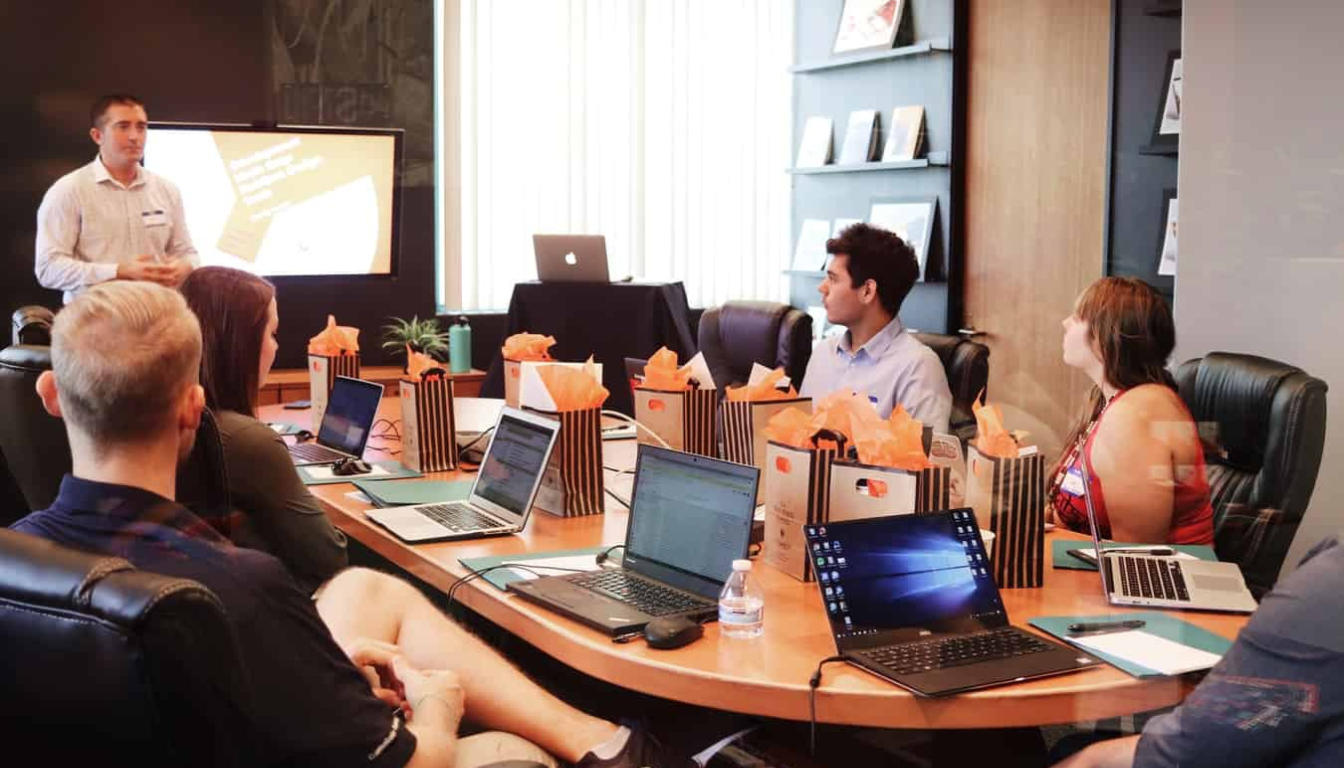The Advantages of Onsite Meetings: Boosting Collaboration and Productivity

Why are onsite meetings important? Onsite meetings enhance collaboration, improve communication, and boost productivity through face-to-face interactions. This article explores these benefits and provides practical tips for planning effective onsite meetings.
Key Takeaways
- Onsite meetings enhance collaboration through improved communication, immediate access to resources, and stronger team relationships.
- Physical presence in meetings fosters accountability, boosts morale, and increases overall productivity by minimizing distractions.
- Effective planning and selection of a suitable meeting space are crucial for maximizing the benefits and outcomes of onsite meetings.
Understanding Onsite Meetings

Onsite meetings, as the name suggests, are gatherings held at a company’s physical location. Unlike offsite or virtual meetings, these meetings leverage the physical presence of attendees to foster a culture of collaboration. When team members share the same space, they can communicate more effectively, share ideas seamlessly, and work towards common goals with greater efficiency.
The importance of physical presence in onsite meetings cannot be overstated. It enhances communication clarity and reduces misunderstandings, which are often common in virtual settings. The ability to read body language, hear the tone of voice, and engage in spontaneous discussions makes these meetings invaluable for effective collaboration.
Onsite meetings also facilitate a deeper connection among team members. When colleagues interact face-to-face, they build stronger relationships and a sense of camaraderie that goes beyond the professional realm. This culture of collaboration not only boosts individual productivity but also contributes to the overall success of the organization.
Immediate Access to Resources
One of the standout benefits of onsite meetings is the immediate access to essential resources. In a physical office setting, participants can quickly retrieve documents, tools, and other materials needed to streamline discussions and decision-making processes. This access ensures that meetings are efficient and focused, allowing for swift resolutions and effective project execution.
Moreover, having all necessary resources at hand eliminates the delays often experienced in virtual meetings, where participants might struggle with slow internet connections or misplace important documents. The combination of immediate access to office resources and thorough preparation ensures that onsite meetings are not only productive but also crucial for achieving successful outcomes.
Enhanced Team Collaboration
In-person meetings are a catalyst for enhanced team collaboration. When employees gather in a traditional workspace, the opportunities for spontaneous interactions and informal discussions increase significantly. These interactions are pivotal for reinforcing team cohesion and fostering stronger team relationships, which are essential for long-term workplace success.
Onsite meetings also eliminate many of the technical barriers associated with virtual meetings. The direct communication and personal interaction they offer lead to higher employee engagement and participation. Teams that meet face-to-face generate more creative ideas and innovative solutions, with studies showing a 15% to 20% increase in creative ideas during in-person meetings.
Another significant advantage is the enhanced networking opportunities that physical proximity provides. Employees can connect with a wider range of colleagues, building relationships that might not have formed in a virtual environment. This networking is not just beneficial for individual career growth but also for the organization’s collaborative culture, offering more flexibility.
Building Stronger Relationships
Face-to-face interactions during onsite meetings are essential for nurturing long-term workplace relationships in the world of business. A significant majority of professionals affirm the importance of these interactions for building deeper connections among team members. The physical presence of colleagues fosters a sense of accountability and encourages a collaborative approach to problem-solving.
Regular onsite interactions contribute to creating a sense of community among employees, positively affecting their morale. Additionally, surveys indicate that remote employees often feel their opportunities for mentorship and professional growth decline when working from home. Onsite meetings help address these concerns by providing a platform for mentorship and career development through direct interactions.
Increased Productivity
Onsite meetings are a powerful tool for enhancing productivity. The direct communication they facilitate leads to faster decision-making and reduces the chances of misunderstandings. Many remote workers report significant distractions at home, which impede their overall productivity. Onsite meetings, by contrast, provide a dedicated meeting space that helps employees focus better and accomplish more in less time.
The structured environment of onsite meetings increases engagement and efficiency, ensuring that more work gets completed in a shorter period. This increased productivity is beneficial not only for individual employees but also for the company’s overall business performance.
Better Confidentiality and Security
Maintaining strong security measures for sensitive information is another advantage of onsite meetings. Conducting meetings in a controlled office environment significantly reduces the risk of data breaches. The physical presence of team members allows for immediate oversight of data handling practices, ensuring confidentiality and security.
Moreover, onsite meetings enhance trust and accountability in data management. Participants are more likely to adhere to security protocols when they are physically present and can directly oversee the handling of sensitive information. This added layer of security is crucial for companies dealing with confidential data.
Effective Problem Solving
Onsite meetings are instrumental in effective problem-solving. The immediate access to office resources and team members enables quick resolution of issues as they arise. This efficiency is further enhanced by the physical presence of shared resources, which reduces delays and expedites project execution.
In-person collaboration allows for spontaneous discussions that can lead to innovative solutions and faster problem-solving. The ability to immediately address and resolve issues during onsite meetings is a significant advantage over virtual settings, where communication delays can hinder problem-solving efforts.
Boosting Employee Morale
Onsite meetings play a crucial role in boosting morale and collaboration. By fostering a sense of belonging and providing structured environments, these meetings significantly uplift the mood and motivation of employees. The recognition of individual contributions in a face-to-face setting further enhances morale and encourages a positive work environment.
A hospitality-driven meeting space can also enhance the attendee experience, offering services like catering and logistics support that make participants feel valued and appreciated. This attention to detail contributes to maintaining high employee morale, productivity, and a much-needed rest, as the host ensures a welcoming environment.
Case Study: Successful Onsite Meeting

A prime example of a successful onsite meeting is Kiwiplan’s team building event at Wild Estate. This event highlighted the benefits of removing management barriers and fostering better interpersonal relationships among staff. The success of the meeting was attributed to thorough planning and attention to detail, ensuring a seamless experience for all participants that was built on the idea of creating an inclusive environment for all attendees on a mission.
Involving offsite workers in the onsite meeting enhanced team cohesion, as they typically interacted less frequently with onsite colleagues. The structured activities and socializing opportunities provided during the event helped strengthen team dynamics and build rapport through challenges, promoting team bonding and an offsite meeting break in routine.
This case study showcases how combining structured activities with socializing opportunities can lead to a successful onsite meeting that boosts team morale and collaboration.
Planning an Effective Onsite Meeting

Planning an effective onsite meeting requires meticulous attention to detail. Setting clear objectives and understanding the audience’s expectations are crucial for ensuring a successful outcome. The planning process involves logistics such as transportation and venue arrangements, which are essential for participant comfort and engagement. A solid plan is key to achieving these goals.
Choosing a suitable venue that matches the meeting’s purpose can significantly enhance the overall experience. The ambiance of the meeting room, including lighting and acoustics, impacts focus and productivity. Flexible layouts are also important, as different meetings may require varying setups to accommodate participants’ preferences.
Incorporating interactive elements and encouraging active involvement among attendees can maximize participation and create a memorable meeting agenda experience. Following up after the meeting with summaries and assigned action items helps ensure accountability and continuity.
Choosing the Right Meeting Space

Selecting the right stage for important meetings is paramount for the success of an onsite meeting. Accessibility and location are crucial factors, as they ensure that all participants can easily attend the meeting. Flexible layout, ambiance, natural light, and modern technology like projectors and reliable Wi-Fi are also important considerations in different locations.
Budget considerations should include evaluating hourly rates and the value of all-inclusive packages for meeting spaces. Ensuring the meeting space is equipped with the necessary technology and amenities can significantly enhance the effectiveness of presentations and discussions, ultimately saving money.
The ambiance of the meeting space, including lighting and acoustics, plays a significant role in maintaining focus and productivity. A well-chosen house site venue can make a substantial difference in the success of an onsite meeting.
Summary
Onsite meetings offer numerous advantages that can significantly enhance the effectiveness of business operations. From immediate access to resources and enhanced team collaboration to building stronger relationships and boosting employee morale, these meetings provide a comprehensive solution for fostering a productive work environment. Companies like Offsite make this possible by offering expertly planned retreats, turnkey logistics, curated team-building experiences, and inspiring venues that take the stress out of coordination and maximize impact.
By understanding the importance of detailed planning and choosing the right meeting space, organizations can ensure the success of their onsite meetings. Embracing the benefits of in-person gatherings can lead to increased productivity, better problem-solving, and a stronger sense of community within the team. So, consider making onsite meetings a regular part of your business strategy to reap these benefits.
FAQs
- What are the main advantages of onsite meetings over virtual meetings?
Onsite meetings provide immediate access to resources and foster stronger team collaboration and relationship-building. Additionally, they ensure a controlled environment for enhanced confidentiality and security.
- How do onsite meetings boost productivity?
Onsite meetings significantly boost productivity by facilitating faster decision-making and minimizing distractions, allowing employees to concentrate fully on their tasks. This focused environment ultimately accelerates the completion of work.
- What should be considered when planning an onsite meeting?
When planning an onsite meeting, it's essential to set clear objectives and understand your audience's expectations while managing logistics like transportation and venue selection. Choosing a suitable venue that aligns with the meeting's purpose and incorporating interactive elements will enhance engagement and effectiveness.
- How do onsite meetings enhance team collaboration?
Onsite meetings enhance team collaboration by eliminating technical barriers and fostering direct communication, which strengthens relationships and boosts engagement. This environment encourages spontaneous interactions that can lead to increased creativity and productivity.
You may also like
Unique spaces for your next offsite
Find distinctive venues for your upcoming corporate retreat.
Stay Updated with Our Insights
Get exclusive content and valuable updates directly to you.







